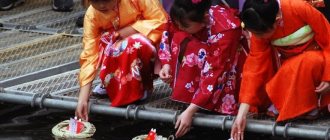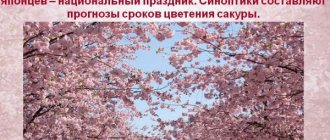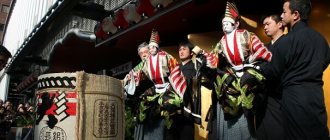History of the Tanabata holiday
The Kyoto Imperial Court is where Tanabata was first celebrated. Japanese nobles began to hang tanzaku on trees, which looked like pieces of colored paper with wishes written in verse.
Later this tradition spread throughout Japan. Fireworks, noisy and colorful parades, and folk festivals were added to the celebration.
Japanese woodblock print of Tanabata festivities in Edo (Tokyo), 1852, by Hiroshige
Much of the modern Tanabata festival has been introduced from Obon. The history of the emergence of this tradition is explained by the Japanese using one legend.
In Japan, they believe that the daughter of the heavenly ruler Tenko, named Orihime, knew how to weave and spin such wonderful clothes that she was forced to do this all her free time. The father was very proud of his daughter’s skills and demanded that she tirelessly improve them.
The girl was glad to serve her father, but was sad that she could not meet love due to continuous weaving. Then Tenko decided to introduce her to the cow herder Hikoboshi, who was tending a herd on the other side of the heavenly river.
The moment the young people saw each other, they fell in love. After their wedding, everything went well, only Orihime did not have time to create clothes for the heavenly emperor. Tenko became angry and separated the lovers. Orihime began sewing again, but was so sad that her work became worthless. Tenko allowed his daughter to see her beloved, but here, too, certain difficulties arose.
To get to the other side, the girl needed a bridge. She sobbed so much that magpies flocked to her cry and promised to build a bridge. Only the birds did not keep their promise, so Orihime and Hikoboshi come to the banks of the heavenly river every year on a certain day, hoping for the fulfillment of their desires.
This legend explains the fact that on Tanabata all little girls and adult seamstresses are congratulated, wishing them to achieve success in their work.
Tanabata in Japan
Tanabata in Japan is a holiday dedicated to the romantic feeling of love. Don't look for distinctive features and make comparisons with Valentine's Day. Still, Asian culture has fundamental differences from European culture. A similar holiday is celebrated in neighboring China. After reading this article, you will get to know the legend associated with this summer love festival on the island. You will also learn about the tradition of its celebration.
1. Different names for the Tanabata holiday
The word Tanabata translates as "Seventh". This is the seventh day of the seventh month according to the lunar calendar. According to the Gregorian calendar, this date falls at the beginning of August. This day is also called the Star Festival (Hoshi Matsuri). The appearance of this unusual festival is associated with a romantic legend.
2. The legend of “heavenly love” in Japan
This legend is widespread in the countries of Southeast Asia. We present here one of its interpretations. In the starry sky lived the daughter of the heavenly king Tenko, a beautiful princess named Orihime, who wove a starry blanket. One day she saw a beautiful young man, Hikoboshi, who was a cow herder. The young people fell in love with each other and forgot about everything in the world. Of course, they forgot about their “heavenly duties.”
The heavenly king, having learned about this, decided to separate the lovers forever. He separated them by a heavenly river. And only after much persuasion and bitter tears of the loving couple, the cruel father allowed them to cross this heavenly barrier once a year. The boy and girl were given the opportunity to see each other on the seventh day of the seventh month.
3. Heroes of the legend of “heavenly love” on the Star Map of the sky
The heroes of the legend of “heavenly love” can be found on the Star Map of the sky. In the constellation Lyra is the bright blue star Vega. This is the princess, yearning for her lover. In the constellation Aquila there is another bright white star of a desperate lover - Altair. It is not difficult to guess that this is a love-sick shepherd. The Milky Way separates the constellations in which these stars are located.
These two stars are the brightest stars of the Great Summer Triangle in the northern hemisphere of the celestial sphere. Of course these are fixed stars. However, residents of the Land of the Rising Sun believe that once a year on the night of the seventh, Vega and Altair approach each other...
And incorrigible romantics believe that Orihime and Hikoboshi cross the Milky Way. After all, love must sweep away all the obstacles that stand in its way...
4. History of Tanabata celebrations in Japan
The holiday was first celebrated in the eighth century (755). At this time, the tradition of celebrating Arts Day, which came from China, took hold in Japan. But back then it was the privilege of a select few. The imperial family and the aristocracy close to it took part in the festive events. Tanabata began to be widely celebrated among the people only in the 17th century. Then the festival finally acquired modern features.
5. How is Tanabata celebrated in Japan?
The Japanese are very upset if it rains on this day... This means that Hikoboshi could not get to his beloved. She cries and her tears fall to the Earth in the form of rain. However, there is always hope that the long-awaited meeting will take place in a year...
The Tanabata Festival is one of the favorite holidays in Japan. It is held in all corners of this island state. Each prefecture, each city brings its own bright colors to the universal holiday of love! City streets and shopping centers are dressed up in traditional Japanese decorations with ribbons.
Bamboo branches are installed everywhere, onto which long multi-colored paper strips are attached. They are called tanzaku. The Japanese write their wishes in verse on them. Young unmarried Japanese women ask to send them a meeting with their only love in life.
During the holiday, colorful parades and processions dedicated to the Star Festival are held. Concerts and competitions to select “Miss Tanabata” are held. The pageants feature scenes from the legend of Orihime and Hikoboshi.
Lanterns are launched into the sky. Sweet treats on trays are presented in abundance for lovers and everyone. And at night, the sky is illuminated by numerous fireworks, which are launched to illuminate the way for the starry couple of lovers...
The largest celebration is held in the city of Hiratsuka, where it lasts for several days. The Tanabata holiday is especially popular among students, as well as among the student community in Japan.
This is how Tanabata is done in Japan! Perhaps on a warm summer night in early August, looking at the starry sky, you will be able to find the stars Vega and Altair there. Remember the legend of their love and tell your friends or loved ones about it!
Read about Valentine's Day in China (Chinese version of Tanabata) here:
Valentine's Day in China
How is Tanabata celebrated today?
Modern Tanabata is celebrated on a grand scale. In Sendai, the festival lasts three whole days. In other cities, preparations for it begin on July 6. Schoolchildren, students and the older generation are involved in this celebration. All over Japan on July 7th you can see notes hanging on trees where people have indicated their wishes for the current year.
On Tanabata, poems are read, songs are sung, and fairs are held. The ruling dynasty appears on the main veranda of their palace to recite waka poetry for the people. This holiday includes everything: from small to large.
Legend
Orihime (lit. “spinning princess”, 織姫 / Orihime), the daughter of the heavenly ruler Tentei (天帝 / Tentei), weaved beautiful robes on the banks of the heavenly river Amanogawa (天の川 / Milky Way). Day after day she worked hard and tried.
However, Orihime soon became sad because due to her hard work, she would never be able to meet and love anyone. Concerned about his daughter's feelings, he arranged for her to meet the heavenly shepherd Hikoboshi (lit. "herding cows", 彦星 or 牽牛/ Hikoboshi), who lived and worked on the other side of the heavenly Amanogawa River. When the princess and Hikoboshi met, they immediately fell in love with each other, and soon got married.
However, after getting married, Orihime could no longer spin the clothes so beloved by her father, and Hikoboshi’s herds began to wander across the heavenly fields of the Universe. In anger, Tentei separated the two lovers on opposite sides of Amanogawa and forbade them to meet.
Orihime fell into despair over parting with her husband and tearfully asked her father to allow them to meet again. Tentei was touched by his daughter's tears and allowed them to see each other on the seventh day of the seventh month if she worked hard and finished weaving. When Orihime and her husband tried to meet, they discovered that they could not cross the heavenly river because there was no bridge. Orihime cried so much that a flock of magpies flew in to hear her cry and the birds promised the lovers to make a bridge with their wings so that they could cross the river.
They say that if it rains on Tanabata, the magpies will not be able to fly to fulfill their promise and help the lovers and they will have to wait another whole year before their next meeting. In different versions of this legend, the lovers have different names. Orihime could be called Tanabata-tsume, Me-Tanabata-sama, Asagao-hime, Ito-ori-hime, Momoko-hime, Takimono-hime. Variations of Hikoboshi – Kaiboshi or Kengyu.
If you go out into nature on a clear August night (to a place where city lights do not drown out the light of the stars) and look at the sky, you can see the Milky Way - in Japan it is called the Great Heavenly River. It's hard to believe, but this mighty star river did not always divide the High Heaven Plain.
Once upon a time, the heavenly plain could be crossed from end to end without encountering obstacles, and in the very middle of it stood the Heavenly Palace, surrounded by a beautiful garden, divided into four parts according to the number of seasons.
Among the autumn mountains, the green foliage has not yet turned red at all, but this morning the wind began to blow, so cold, as if frost had fallen.
However, our legend is not about the garden or the palace, but about its inhabitants. In the women's quarters of the palace lived a beautiful star - Vega-Tkachika. She wove a heavenly blanket day and night, making the days in the Middle Country sunny and the nights clear. Altair, the Heavenly Shepherd, lived in the southwestern chambers. He tended the starry herds on the heavenly plains. And the cycle of days and nights created by the work of the Weaver and the Heavenly Shepherd was so beautiful that even the gods, led by Amaterasu, admired them.
Good karma - the Weaver and the Shepherd were destined to reunite in this incarnation. The wedding was celebrated with pomp and scale, worthy of the celestials.
Never before had the Shepherd seen such a beautiful girl. Admired, he could not take his eyes off her: the silk of her long dark hair was perfect for binding the messages most dear to the heart, her movements were smooth and full of grace, and from the loving gaze of the Shepherd the Weaver blossomed with a beautiful blush - because there was none on the entire Heavenly Plain no one who would move her heart more.
You threw away the curtain and on a windy night you invited me to spend the night with you. And then the Moon quietly fell onto my sleeve from the Heavenly River.
Their love was so strong that even a momentary separation seemed a burden to the spouses. The loom was abandoned, the star herds wandered wherever they pleased, trampling the heavenly gardens and disturbing the crystal of the star streams.
The nights below, on earth, were dark and terrible, fishermen lost their way home, the mountains groaned, frightening the lumberjacks. People prayed to the gods, asking them to avert the attack, and Amaterasu heeded their prayers - in order to restore order of things, she had to separate the lovers.
The Goddess ordered the Weaver to work more diligently at the loom, and returned the Shepherd to the pastures. And so that they could not meet, a wide and deep river separated them; we call it the Milky Way.
The Weaver cried bitterly, sitting at the loom, and the fabric came out uneven and dull from tears. The more the Weaver cried, the wider the river spread. The shepherd was sad. His flute poured out songs full of sadness, and the forgotten herds thinned day by day. The time of rain reigned on the earth, and the songs of the heavenly flute mixed with the sad whistle of the wind.
As long as I live, I will wait, my love, I will wait until you come, Oh! Long wait! Until the frost falls on the strands of black flowing hair
Amaterasu, touched by the power of their love, softened. Having learned that the lovers were sending each other messages with the magpie, she caught the messenger and ordered her to gather the magpie people once every seven days and build a light, winged bridge across the Heavenly River so that the spouses could still meet.
Who knows, maybe if Amaterasu had chosen another bird, everything would have turned out differently... It turned out that the magpie got everything mixed up. And since then, the magpies have gathered to build a living bridge, but not once a week, but only once a year - on the 7th day of the 7th month.
If the weather is inclement on this day, the waters of the Heavenly River begin to boil and foam, the bridge scatters in different directions, and the lovers cannot meet. The sky is crying with rain, and with it the Shepherd and the Weaver are crying bitterly.
But if it is clear, the wind does not disturb the surface of the Great Heavenly River - the magpies make a crossing, and the lovers meet, albeit for a short time. This is when the Tanabata holiday begins in Japan - a holiday of prosperity, love, hope and dreams coming true.
Tanabata is one of the five major Japanese holidays. The legend of the Weaver and the Shepherd has inspired many generations of poets; poetry competitions have been held on this day for a long time, and in poetry anthologies entire sections are devoted to the meeting of lovers.
There was a long-standing custom: on Tanabata, narrow strips of paper with wishes were tied to young bamboo shoots. Bamboo shoots grew quickly - it was believed that this way people’s aspirations and hopes reach the sky faster.
On the seventh day of the seventh month, the Japanese traditionally pray for excellence in any craft (in particular, success in the art of calligraphy), final exams are held in higher education, and celebrations are held with fireworks and kite flying.
We recommend watching the wonderful cartoon “Japanese Lullaby”, created by Natalya Romanenko as part of the “Lullabies of the World” project, based on the legend of the shepherd and the weaver:
Japanese festival Tanabata Matsuri: legend, customs and traditions
In Japanese traditions, a sense of beauty has always been very clearly manifested, which developed for many centuries in a row and turned over time into a kind of cult of worship of beauty. Aesthetic enjoyment of nature is reflected in traditional celebrations and festivals dedicated to trees, flowers, birds, wind, moon or stars. One of these beautiful holidays is the Tanabata festival, which has enjoyed constant popularity among all segments of the Japanese population for many centuries.
The Tale of the Seventh Evening
The Tanabata Festival is not a public holiday in Japan and is not a public holiday. But still, of all the summer holiday events, it is the most beloved and long-awaited in the Land of the Rising Sun. The name of the Tanabata festival is translated from Japanese as “seventh evening”, which indicates the date of its holding: on the seventh evening of the seventh month, i.e. July 7.
Along with this name, a more romantic name was assigned to the festival - Hoshi Matsuri (Star Festival), since the basis for the plot of the holiday was a beautiful fairy tale, the heroes of which are two stars Vega (the constellation of Lyra) and Altair (the constellation of the Eagle).
The simple plot of the fairy tale “love story”, found in the folklore of many Asian countries, was based on an ancient Chinese legend. In Japan, the tale was supplemented with local beliefs, so different parts of the country have their own versions of this legend.
The most common fairy tale tells about the eternal love of Princess Orihime (Vega) and Bootes Hikoboshi (Altair). The daughter of the heavenly king had a heavy and responsible burden - hide the heavenly brocade (clouds), while Bootes watched over a herd of cows on the banks of a beautiful river (Milky Way).
Having met each other, the young people plunged headlong into the pool of love and abandoned their work, which caused the serious anger of Tenko, the heavenly king. He had the power to separate the lovers forever, dividing them by a huge river. But taking pity on the bitter tears of his inconsolable daughter, the king allowed them to see each other. True, the meeting of the Princess and Bootes occurs only once a year - July 7 , when the stars Vega and Altair are located as close to each other in the sky as possible.
Customs of Tanabata Matsuri
The Star Festival in its usual manifestation became a national holiday at the beginning of the 17th century, when the traditions and ceremonies of the “Petition for Mastery” festival, which was celebrated at the court of the emperor and among the palace aristocracy for several centuries, began to take root among the broad masses. Later, the romantic legend of star love became the basis for the incredibly beautiful Tanabata festival with fireworks, processions, and festive decorations of city streets.
But the customs of the festival dedicated to the arts were also not forgotten. Princess Orihime (patron of various arts) was traditionally asked for inspiration in the arts of sewing, weaving (for girls) and drawing, calligraphy (for boys).
Modern Japanese also prepare special paper petitions - tanzaku - for the day of the Tanabata Festival, on which they write their wishes (often in poetic form). Tanzaku are long, thin strips of various colors that are attached to bamboo branches that are placed everywhere near doors and gates.
Initially, decorated bamboo shoots were installed on the banks of rivers, canals and other bodies of water, keeping in mind the heavenly river separating a couple in love. But over time, they also began to decorate residential buildings and public institutions. Clean tanzaku and writing materials are often left near them for anyone who wants to create their own petition to Orihime or Hikoboshi.
The Tanabata festival is most popular among romantically inclined teenagers and students, who prepare for the celebration with special zeal. The territory of college campuses during the Star Festival in Japan is simply transformed. Here and there, tanzaku (sometimes in the shape of a heart), paper lanterns and talismans are hung on trees, stages are built for amateur concerts, and trays with treats are prepared.
The Tanabata festival reaches its climax in the late afternoon, when the skies are colored with fireworks, as if illuminating the path for heavenly lovers to meet each other. Thousands of earthly girls and boys wait with bated breath for their cherished wish written on tanzaku to come true, and for them to find their one and only love.
Prayers to the stars
When the Tanabata holiday first appeared in Japan, ceremonies were held in the palace on this day, during which aristocrats composed Japanese and Chinese poems while looking at the stars. During the Edo period (1603-1868), the celebration of Tanabata spread among the common people, and a special Japanese custom developed of writing wishes on colored paper ribbons called tanzaku, which were tied to the branches of thin sasatake bamboo.
Tanzaku ribbons on holiday decorations
In addition to tanzaku, bamboo is decorated with fukinagashi ribbons, symbolizing threads, and thus pray for success in weaving. To ensure a good fish catch, they make amikazari jewelry that resembles a fishing net, and for success in business they use kinchaku jewelry, similar in shape to a purse with coins. The crane is a symbol of longevity and therefore paper cranes are also used for holiday decorations. All these decorations are easily folded from paper using the traditional Japanese origami technique. Previously, bamboo stalks with attached decorations were thrown into the river to send prayers to the deities, but recently this has been done less and less so as not to harm the environment.
In the old days, it was believed that the sasatake bamboo stretching into the sky, whose leaves rustle in the heights, was capable of carrying prayers to the heavens, and therefore they began to use it for holiday decorations. In addition, it was believed that bamboo could protect grain ears from insects, and it symbolized prayers for the harvest.
On the Tanabata holiday, it is customary to eat somen noodles, which are thin and shaped like silk threads. From China came the tradition of eating sakubei sweets, shaped like a twisted rope, to protect against diseases, but in Japan they subsequently began to use somen noodles, which are most often eaten chilled in the hot season. Kids love the stream-like noodles garnished with slivers of green okra (okra) that look like stars.
The Legend of Tanabata
High-tech Japan honors its traditions. The Japanese know that the Tanabata legend begins with the story of how the daughter of the King of Heaven, Orihime, spins cloth on the banks of the Heavenly River. The girl's work is hard and monotonous. This always makes the princess sad. Her father, concerned about his daughter's condition, decides to introduce her to Hikoboshi. A young man occupies the position of shepherd of heavenly cows in Heaven.
Young people fall passionately in love with each other. They receive permission from Heavenly Father to get married. After her marriage, Orihime no longer spins cloth. Hikoboshi does not fulfill his duties, does not look after the herd. Then the Heavenly Father begins to get angry and separates the lovers. He sends Hikoboshi and Orihime to live on opposite sides of the river.
Interesting to know: In Japanese legend, the fate of the lovers turns out relatively well. The King of Heaven allows them to meet every seventh month, but only on the 7th. For a year, lovers must fulfill responsibilities. Then they deserve the right to a meeting.
Another legend connected with this story is that Hikoboshi and Orihime could not meet every year even with the permission of the Father. Because the Heavenly River has no bridge. In Japan, they believe that magpies organize a meeting between lovers every year. The birds form a bridge from their wings, along which they carry the girl to the other side of the river.










